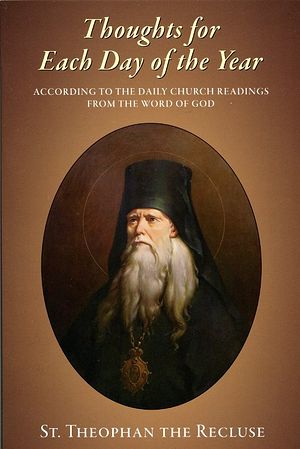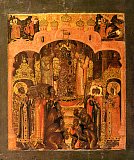

| Previous day | Next day |
| Old Style
September 14
|
Sunday |
New Style
September 27
|
|
17th Sunday after Pentecost.
Tone 8.
Strict fast. |
Wine and oil allowed.
|
![]() The Universal Exaltation of the Precious and Life-giving Cross.
The Universal Exaltation of the Precious and Life-giving Cross.
![]() Repose of St. John Chrysostom, archbishop of Constantinople (407).
Repose of St. John Chrysostom, archbishop of Constantinople (407).
Uncovering of the relics (2000) of Sts. Alexandra (1789), Martha (1829), and Helen (1832), of Diveyevo.
Lesna Icon of the Most Holy Theotokos (1683).
Martyr Papas of Lycaonia (305). St. Placilla the Empress, wife of St. Theodosius the Great (400). St. Maria of Tarsus (607). New Martyr Macarius of Thessalonica (Mt. Athos), disciple of St. Niphon, patriarch of Constantinople (1527). Holy Fathers of the Sixth Ecumenical Council (680-681) (Gr. Cal).
Repose of Bishop Arsenius (Zhadanovsky) of Serpukhov, Archpriest Sergius Siderov of Kiev, and Priest Michael Shik of Moscow (1937).
Thoughts for Each Day of the Year
According to the Daily Church Readings from the Word of God
By St. Theophan the Recluse

[Eph. 5:20-26; Luke 3:23-4:1]
The honourable cross is brought out for veneration in the middle of Great Lent in order to inspire those who toil in fasting to patiently bear the yoke they have taken to the end. Why is this done in September? Is it accidental? But there are no accidents for the Providential Wisdom that arranges all things. This is why: [in Russia], at least, in September the harvest is taken from the field. And so that some of the Christians might not feel too satisfied and say: “Soul, thou hast much goods laid up for many years; take thine ease, eat, drink, and be merry!” and so that others might not fall in spirit because of scarcity, the elevated cross is brought before all. It reminds the former that the support of well being is not possessions, but their bearing of the cross in a Christian, inner way, should God’s goodness bring external plenitude; and it inspires the latter to possess their souls in patience, through the certainty that they will go from the cross directly to heaven. Therefore, may some endure, knowing, that they are travelling a smooth path to the heavenly kingdom; and may the others enjoy external comforts with fear, not sealing the entrance to heaven against themselves.
